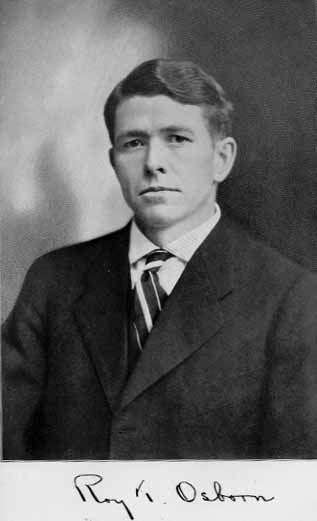
Roy T. Osborn, probate judge of Montgomery county, is a lawyer by profession. He was born in Atchison county, Missouri, Nov. 30, 1874. His parents are Hon. Stephen J. and Arabella T. (McCreary) Osborn. (See sketch of Stephen J. Osborn.) His father is one of the most distinguished lawyers and jurists of Kansas, to which state he came from Missouri in the spring of 1879, settling in the following fall at Wakeeney, Trego county. When his father located at Wakeeney, Roy T. Osborn was but five years of age. At Wakeeney he obtained his preliminary education, in the public schools, and was then for five years a student in the Kansas Wesleyan College, at Salina. In the fall of 1895 he entered the junior class of the University of Kansas, where he graduated in 1897, receiving the degree of Bachelor of Arts. Predilection led him to study law, and in the year 1899 he returned to the University of Kansas to take up the study of that profession, graduating in 1900 and receiving the degree of Bachelor of Laws. Immediately after his graduation in law he located at Coffeyville, Kan., where for six months he was associated in the practice with Hon. Thomas E. Wagstaff. He then became a government employee, in the law department of the commission created by Congress to look after the interests of what was and is known as "the five civilized Indian tribes." This position he resigned in 1904 to practice law at Coffeyville, in association with his father, who had previously removed to that place. His former partner in the law, Hon. Thomas E. Wagstaff, was elected county attorney of Montgomery county, and under him Mr. Osborn served efficiently as assistant county attorney, from 1905 until 1907. He had become well and favorably known as a lawyer and as a Republican leader in politics, and in 1908 was made the nominee of his party for probate judge of Montgomery county. He was elected to this position at the fall election of that year, and was reëlected in the fall of 1910, his present term expiring in January, 1913. To say that in the opinion of the people of Montgomery county he has rendered acceptable and satisfactory services as probate judge would be speaking in modest terms of his record in the office. Judge Osborn has long sustained prominent fraternal relations. He is a member of the Benevolent and Protective Order of Elks and of the Knights of Pythias order, and during his college days became a member of the Sigma Chi and Phi Delta Phi fraternities. It is to the younger men that any state must look for future leaders in public affairs, and to Judge Roy T. Osborn, of Independence, the State of Kansas may well afford to look for one of those, who shall shape her future policies. In 1904, Judge Osborn married Mrs. Martha DeWitt, nee Turner.
Pages 600-601 from volume III, part 1 of Kansas: a cyclopedia of state history, embracing events, institutions, industries, counties, cities, towns, prominent persons, etc. ... / with a supplementary volume devoted to selected personal history and reminiscence. Standard Pub. Co. Chicago : 1912. 3 v. in 4. : front., ill., ports.; 28 cm. Vols. I-II edited by Frank W. Blackmar. Transcribed December 2002 by Carolyn Ward. This volume is identified at the Kansas State Historical Society as microfilm LM195. It is a two-part volume 3.
![]()
TITLE PAGE / LIST OF ILLUSTRATIONS
INTRODUCTION
A | B | C | D | E | F | G | H | I
VOLUME II
TITLE PAGE / LIST OF ILLUSTRATIONS
J | K | L | Mc | M | N | O | P | Q | R | S | T | U | V | W | X | Y | Z
VOLUME III
BIOGRAPHICAL INDEXES
